
Illustrative Math Alignment: Grade 7 Unit 7
Expressions, Equations, and Inequalities
Lesson 9: Dealing with Negative Numbers
Use the following Media4Math resources with this Illustrative Math lesson.
| Thumbnail Image | Title | Body | Curriculum Topic |
|---|---|---|---|
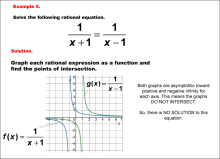
|
Math Example--Graphical Solutions to Rational Equations--Example 5 | This is part of a collection of math examples that show how to use graphical techniques to solve rational equations.
Note: The download is an image file.
Related ResourcesTo see additional resources on this topic, click on the Related Resources tab.Create a Slide ShowSubscribers can use Slide Show Creator to create a slide show from the complete collection of math examples on this topic. To see the complete clip art collection, click on this Link. To learn more about Slide Show Creator, click on this Link:AccessibilityThis resource can also be used with a screen reader. |
Rational Functions and Equations |
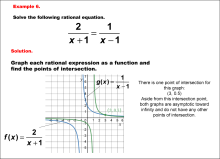
|
Math Example--Graphical Solutions to Rational Equations--Example 6 | This is part of a collection of math examples that show how to use graphical techniques to solve rational equations.
Note: The download is an image file.
Related ResourcesTo see additional resources on this topic, click on the Related Resources tab.Create a Slide ShowSubscribers can use Slide Show Creator to create a slide show from the complete collection of math examples on this topic. To see the complete clip art collection, click on this Link. To learn more about Slide Show Creator, click on this Link:AccessibilityThis resource can also be used with a screen reader. |
Rational Functions and Equations |
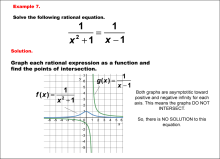
|
Math Example--Graphical Solutions to Rational Equations--Example 7 | This is part of a collection of math examples that show how to use graphical techniques to solve rational equations.
Note: The download is an image file.
Related ResourcesTo see additional resources on this topic, click on the Related Resources tab.Create a Slide ShowSubscribers can use Slide Show Creator to create a slide show from the complete collection of math examples on this topic. To see the complete clip art collection, click on this Link. To learn more about Slide Show Creator, click on this Link:AccessibilityThis resource can also be used with a screen reader. |
Rational Functions and Equations |
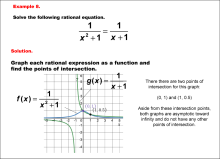
|
Math Example--Graphical Solutions to Rational Equations--Example 8 | This is part of a collection of math examples that show how to use graphical techniques to solve rational equations.
Note: The download is an image file.
Related ResourcesTo see additional resources on this topic, click on the Related Resources tab.Create a Slide ShowSubscribers can use Slide Show Creator to create a slide show from the complete collection of math examples on this topic. To see the complete clip art collection, click on this Link. To learn more about Slide Show Creator, click on this Link:AccessibilityThis resource can also be used with a screen reader. |
Rational Functions and Equations |
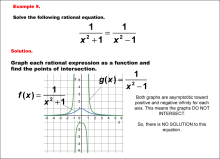
|
Math Example--Graphical Solutions to Rational Equations--Example 9 | This is part of a collection of math examples that show how to use graphical techniques to solve rational equations.
Note: The download is an image file.
Related ResourcesTo see additional resources on this topic, click on the Related Resources tab.Create a Slide ShowSubscribers can use Slide Show Creator to create a slide show from the complete collection of math examples on this topic. To see the complete clip art collection, click on this Link. To learn more about Slide Show Creator, click on this Link:AccessibilityThis resource can also be used with a screen reader. |
Rational Functions and Equations |

|
Math Example--Linear Function Concepts--Linear Equations in Standard Form: Example 1 | Math Example--Linear Function Concepts--Linear Equations in Standard Form: Example 1TopicLinear Functions DescriptionThis example demonstrates the process of converting a linear equation from standard form to slope-intercept form. The equation 2x + 4y = 8 is solved step-by-step, isolating y and dividing by its coefficient. The result is y = -1/2 x + 2, clearly showing the slope and y-intercept of the line. |
Standard Form |
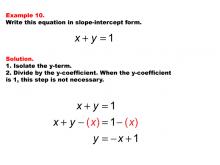
|
Math Example--Linear Function Concepts--Linear Equations in Standard Form: Example 10 | Math Example--Linear Function Concepts--Linear Equations in Standard Form: Example 10TopicLinear Functions DescriptionThis example illustrates the conversion of the linear equation x + y = 1 from standard form to slope-intercept form. The process involves isolating y, resulting in y = -x + 1. This simple transformation clearly reveals the slope and y-intercept of the line. |
Standard Form |
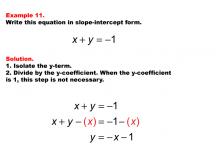
|
Math Example--Linear Function Concepts--Linear Equations in Standard Form: Example 11 | Math Example--Linear Function Concepts--Linear Equations in Standard Form: Example 11TopicLinear Functions DescriptionThis example showcases the transformation of the linear equation x + y = -1 from standard form to slope-intercept form. The process involves isolating y, resulting in y = -x - 1. This step-by-step solution clearly reveals the slope and y-intercept of the line. |
Standard Form |

|
Math Example--Linear Function Concepts--Linear Equations in Standard Form: Example 12 | Math Example--Linear Function Concepts--Linear Equations in Standard Form: Example 12TopicLinear Functions DescriptionThis example demonstrates the conversion of the linear equation x - y = 1 from standard form to slope-intercept form. The solution process involves isolating y and changing the sign of both sides, resulting in y = x - 1. This transformation clearly reveals the slope and y-intercept of the line. |
Standard Form |
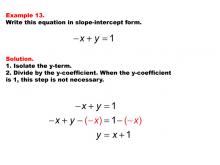
|
Math Example--Linear Function Concepts--Linear Equations in Standard Form: Example 13 | Math Example--Linear Function Concepts--Linear Equations in Standard Form: Example 13TopicLinear Functions DescriptionThis example illustrates the process of converting the linear equation -x + y = 1 from standard form to slope-intercept form. The solution involves rearranging the equation to isolate y, resulting in y = x + 1. This transformation clearly reveals the slope and y-intercept of the line. |
Standard Form |

|
Math Example--Linear Function Concepts--Linear Equations in Standard Form: Example 14 | Math Example--Linear Function Concepts--Linear Equations in Standard Form: Example 14TopicLinear Functions DescriptionThis example demonstrates the conversion of the linear equation -x - y = -1 from standard form to slope-intercept form. The process involves manipulating the equation to solve for y, yielding y = -x + 1. This transformation clearly reveals the slope and y-intercept of the line. |
Standard Form |

|
Math Example--Linear Function Concepts--Linear Equations in Standard Form: Example 15 | Math Example--Linear Function Concepts--Linear Equations in Standard Form: Example 15TopicLinear Functions DescriptionThis example showcases the transformation of the linear equation -x - y = 1 from standard form to slope-intercept form. The solution process involves isolating y, resulting in y = -x - 1. This step-by-step conversion clearly reveals the slope and y-intercept of the line. |
Standard Form |
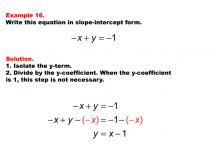
|
Math Example--Linear Function Concepts--Linear Equations in Standard Form: Example 16 | Math Example--Linear Function Concepts--Linear Equations in Standard Form: Example 16TopicLinear Functions DescriptionThis example demonstrates the conversion of the linear equation -x + y = -1 from standard form to slope-intercept form. The process involves isolating y, resulting in y = x - 1. This transformation clearly reveals the slope and y-intercept of the line. Linear functions are fundamental mathematical concepts that describe relationships between two variables. The examples in this collection, such as showing step-by-step transformations from standard form to slope-intercept form, help in understanding how each part of the equation affects the graph and the relationship itself. |
Standard Form |

|
Math Example--Linear Function Concepts--Linear Equations in Standard Form: Example 17 | Math Example--Linear Function Concepts--Linear Equations in Standard Form: Example 17TopicLinear Functions DescriptionThis example illustrates the conversion of the linear equation x - y = -1 from standard form to slope-intercept form. The solution involves isolating y, resulting in y = x + 1. This process clearly reveals the slope and y-intercept of the line. |
Standard Form |
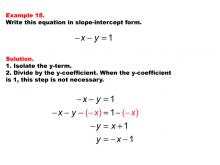
|
Math Example--Linear Function Concepts--Linear Equations in Standard Form: Example 18 | Math Example--Linear Function Concepts--Linear Equations in Standard Form: Example 18TopicLinear Functions DescriptionThis example demonstrates the conversion of the linear equation -x - y = 1 from standard form to slope-intercept form. The process involves rearranging the equation to isolate y, resulting in y = -x - 1. This transformation clearly reveals the slope and y-intercept of the line. |
Standard Form |
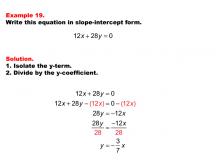
|
Math Example--Linear Function Concepts--Linear Equations in Standard Form: Example 19 | Math Example--Linear Function Concepts--Linear Equations in Standard Form: Example 19TopicLinear Functions DescriptionThis example illustrates the conversion of the linear equation 12x + 28y = 0 from standard form to slope-intercept form. The solution involves isolating y and dividing by its coefficient, resulting in y = -3/7 x. This process clearly reveals the slope and y-intercept of the line. |
Standard Form |
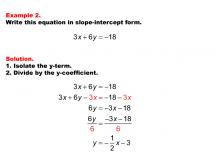
|
Math Example--Linear Function Concepts--Linear Equations in Standard Form: Example 2 | Math Example--Linear Function Concepts--Linear Equations in Standard Form: Example 2TopicLinear Functions DescriptionThis example illustrates the conversion of the linear equation 3x + 6y = -18 from standard form to slope-intercept form. The solution involves isolating y and dividing by its coefficient, resulting in y = -1/2 x - 3. This process clearly reveals the slope and y-intercept of the line. |
Standard Form |
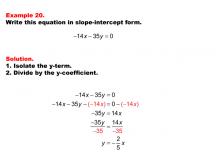
|
Math Example--Linear Function Concepts--Linear Equations in Standard Form: Example 20 | Math Example--Linear Function Concepts--Linear Equations in Standard Form: Example 20TopicLinear Functions DescriptionThis example demonstrates the conversion of the linear equation -14x - 35y = 0 from standard form to slope-intercept form. The process involves isolating y and dividing by its coefficient, resulting in y = -2/5 x. This transformation clearly reveals the slope and y-intercept of the line. |
Standard Form |

|
Math Example--Linear Function Concepts--Linear Equations in Standard Form: Example 21 | Math Example--Linear Function Concepts--Linear Equations in Standard Form: Example 21TopicLinear Functions DescriptionThis example showcases the transformation of the linear equation 28x - 21y = 0 from standard form to slope-intercept form. The process involves isolating y and dividing by its coefficient, resulting in y = 4/3 x. This step-by-step solution clearly reveals the slope and y-intercept of the line. |
Standard Form |
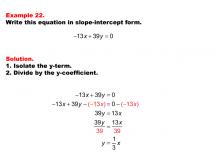
|
Math Example--Linear Function Concepts--Linear Equations in Standard Form: Example 22 | Math Example--Linear Function Concepts--Linear Equations in Standard Form: Example 22TopicLinear Functions DescriptionThis example illustrates the conversion of the linear equation -13x + 39y = 0 from standard form to slope-intercept form. The solution involves isolating y and dividing by its coefficient, resulting in y = 1/3 x. This process clearly reveals the slope and y-intercept of the line. |
Standard Form |
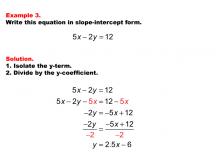
|
Math Example--Linear Function Concepts--Linear Equations in Standard Form: Example 3 | Math Example--Linear Function Concepts--Linear Equations in Standard Form: Example 3TopicLinear Functions DescriptionThis example showcases the transformation of the linear equation 5x - 2y = 12 from standard form to slope-intercept form. The process involves isolating y and dividing by its coefficient, resulting in y = 2.5x - 6. This step-by-step solution clearly reveals the slope and y-intercept of the line. |
Standard Form |
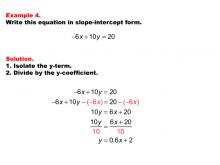
|
Math Example--Linear Function Concepts--Linear Equations in Standard Form: Example 4 | Math Example--Linear Function Concepts--Linear Equations in Standard Form: Example 4TopicLinear Functions DescriptionThis example demonstrates the conversion of the linear equation -6x + 10y = 20 from standard form to slope-intercept form. The solution process involves isolating y and dividing by its coefficient, resulting in y = 0.6x + 2. This transformation clearly reveals the slope and y-intercept of the line. |
Standard Form |
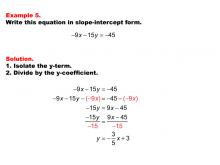
|
Math Example--Linear Function Concepts--Linear Equations in Standard Form: Example 5 | Math Example--Linear Function Concepts--Linear Equations in Standard Form: Example 5TopicLinear Functions DescriptionThis example illustrates the process of converting the linear equation -9x - 15y = -45 from standard form to slope-intercept form. The solution involves rearranging the equation to isolate y, resulting in y = 3/5 x + 3. This transformation clearly reveals the slope and y-intercept of the line. |
Standard Form |

|
Math Example--Linear Function Concepts--Linear Equations in Standard Form: Example 6 | Math Example--Linear Function Concepts--Linear Equations in Standard Form: Example 6TopicLinear Functions DescriptionThis example demonstrates the conversion of the linear equation -8x - 12y = 25 from standard form to slope-intercept form. The process involves manipulating the equation to solve for y, yielding y = -2/3 x - 25/12. This transformation clearly reveals the slope and y-intercept of the line. |
Standard Form |
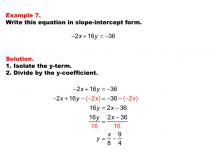
|
Math Example--Linear Function Concepts--Linear Equations in Standard Form: Example 7 | Math Example--Linear Function Concepts--Linear Equations in Standard Form: Example 7TopicLinear Functions DescriptionThis example illustrates the transformation of the linear equation -2x + 16y = -36 from standard form to slope-intercept form. The solution process involves solving for y, resulting in y = 1/8 x - 9/4. This step-by-step conversion clearly reveals the slope and y-intercept of the line. |
Standard Form |
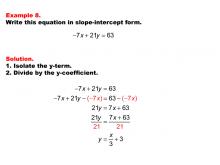
|
Math Example--Linear Function Concepts--Linear Equations in Standard Form: Example 8 | Math Example--Linear Function Concepts--Linear Equations in Standard Form: Example 8TopicLinear Functions DescriptionThis example showcases the conversion of the linear equation -7x + 21y = 63 from standard form to slope-intercept form. The process involves rearranging the equation to isolate y, resulting in y = 1/3 x + 3. This transformation clearly reveals the slope and y-intercept of the line. |
Standard Form |
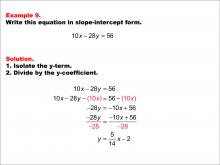
|
Math Example--Linear Function Concepts--Linear Equations in Standard Form: Example 9 | Math Example--Linear Function Concepts--Linear Equations in Standard Form: Example 9TopicLinear Functions DescriptionThis example demonstrates the process of converting the linear equation 10x - 28y = 56 from standard form to slope-intercept form. The solution involves isolating y and dividing by its coefficient, resulting in y = (5/14)x - 2. This transformation clearly reveals the slope and y-intercept of the line. |
Standard Form |
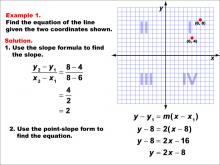
|
Math Example--Linear Function Concepts--The Equation of a Line Given Two Points: Example 1 | Math Example--Linear Function Concepts--The Equation of a Line Given Two Points: Example 1TopicLinear Functions DescriptionThis example demonstrates how to find the equation of a line passing through two given points: (6, 4) and (8, 8). The slope is calculated using the formula (y2 - y1) / (x2 - x1), resulting in a slope of 2. Using the point-slope form of a line, y - y1 = m(x - x1), the equation is derived as y - 8 = 2(x - 8), which simplifies to y = 2x - 8. |
Point-Slope Form and Slope-Intercept Form |
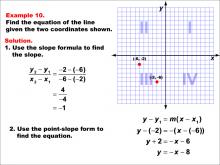
|
Math Example--Linear Function Concepts--The Equation of a Line Given Two Points: Example 10 | Math Example--Linear Function Concepts--The Equation of a Line Given Two Points: Example 10TopicLinear Functions DescriptionThe image shows a coordinate plane with two points (-6, -2) and (-2, -6) marked. It provides a step-by-step solution to find the equation of the line passing through these points. The slope is calculated, and the equation is derived using point-slope form. The slope is calculated as (y2 - y1) / (x2 - x1) = (-6 - (-2)) / (-2 - (-6)) = -4 / 4 = -1. Using point-slope form, y - y1 = m(x - x1), the equation is derived as y + 2 = -(x + 6), which simplifies to y = -x - 8. |
Point-Slope Form and Slope-Intercept Form |
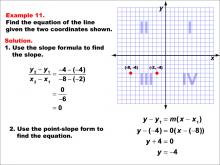
|
Math Example--Linear Function Concepts--The Equation of a Line Given Two Points: Example 11 | Math Example--Linear Function Concepts--The Equation of a Line Given Two Points: Example 11TopicLinear Functions DescriptionThe image shows a coordinate plane with two points (-8, -4) and (-2, -4) marked. It provides a step-by-step solution to find the equation of the line passing through these points. The slope is calculated as zero, indicating a horizontal line. The slope is calculated as (y2 - y1) / (x2 - x1) = (-4 - (-4)) / (-8 - (-2)) = 0 / -6 = 0. Since the slope is zero, it indicates a horizontal line at y = -4. Using point-slope form, the equation becomes y + 4 = 0, which simplifies to y = -4. |
Point-Slope Form and Slope-Intercept Form |
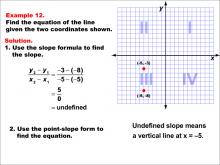
|
Math Example--Linear Function Concepts--The Equation of a Line Given Two Points: Example 12 | Math Example--Linear Function Concepts--The Equation of a Line Given Two Points: Example 12TopicLinear Functions DescriptionThe image shows a coordinate plane with two points (-5, -8) and (-5, -3) marked. It provides a step-by-step solution to find the equation of the line passing through these points. The slope is undefined, indicating a vertical line. The slope is calculated as (y2 - y1) / (x2 - x1) = (-3 - (-8)) / (-5 - (-5)) = 5 / 0, which is undefined. Since the slope is undefined, it indicates a vertical line at x = -5. Therefore, the equation of the line is simply x = -5. |
Point-Slope Form and Slope-Intercept Form |

|
Math Example--Linear Function Concepts--The Equation of a Line Given Two Points: Example 13 | Math Example--Linear Function Concepts--The Equation of a Line Given Two Points: Example 13TopicLinear Functions DescriptionThis image shows a graph with two points (2, -4) and (6, -2) marked. The example demonstrates how to find the equation of a line passing through these points. The slope is calculated as 1/2, and the point-slope form is used to derive the equation of the line. The slope formula is used: (y2 - y1) / (x2 - x1) = (-2 - (-4)) / (6 - 2) = 2 / 4 = 1/2. Then, using the point-slope form: y - (-2) = (1/2)(x - 6), which simplifies to y = (1/2)x - 5. |
Point-Slope Form and Slope-Intercept Form |

|
Math Example--Linear Function Concepts--The Equation of a Line Given Two Points: Example 14 | Math Example--Linear Function Concepts--The Equation of a Line Given Two Points: Example 14TopicLinear Functions DescriptionThis image shows a graph with two points (2, -3) and (5, -6). The example demonstrates how to find the equation of a line passing through these points. The slope is calculated as -1, and the point-slope form is used to derive the equation. The slope formula is used: (y2 - y1) / (x2 - x1) = (-3 - (-6)) / (2 - 5) = 3 / -3 = -1. Then, using the point-slope form: y - (-3) = -(x - 2), which simplifies to y = -x - 1. |
Point-Slope Form and Slope-Intercept Form |
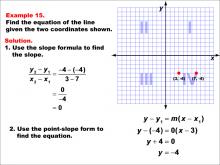
|
Math Example--Linear Function Concepts--The Equation of a Line Given Two Points: Example 15 | Math Example--Linear Function Concepts--The Equation of a Line Given Two Points: Example 15TopicLinear Functions DescriptionThis image shows a graph with two points (3, -4) and (7, -4). The example demonstrates how to find the equation of a horizontal line passing through these points. The slope is calculated as 0, and the point-slope form is used to derive the equation. The slope formula is used: (y2 - y1) / (x2 - x1) = (-4 - (-4)) / (7 - 3) = 0 / 4 = 0. Then, using the point-slope form: y - (-4) = 0(x - 3), which simplifies to y = -4. |
Point-Slope Form and Slope-Intercept Form |
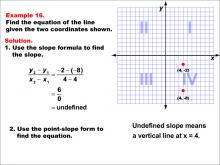
|
Math Example--Linear Function Concepts--The Equation of a Line Given Two Points: Example 16 | Math Example--Linear Function Concepts--The Equation of a Line Given Two Points: Example 16TopicLinear Functions DescriptionThis image shows a graph with two points (4, -8) and (4, -2). The example demonstrates how to find the equation of a vertical line passing through these points. The slope is undefined because division by zero occurs in calculating it. The slope formula is used: (y2 - y1) / (x2 - x1) = (-2 - (-8)) / (4 - 4) = 6 / 0 = undefined. Since this represents a vertical line, its equation is simply x = 4. |
Point-Slope Form and Slope-Intercept Form |
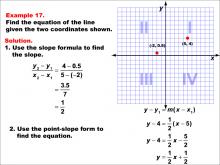
|
Math Example--Linear Function Concepts--The Equation of a Line Given Two Points: Example 17 | Math Example--Linear Function Concepts--The Equation of a Line Given Two Points: Example 17TopicLinear Functions DescriptionThis image shows a graph with two points plotted at (-2, 0.5) and (5, 4). The example demonstrates how to find the equation of a line using the slope formula and point-slope form. The slope is calculated as (4 - 0.5) / (5 - (-2)) = 3.5 / 7 = 1 / 2. The point-slope form is used to find the equation: y - 4 = (1 / 2)(x - 5), resulting in y = (1 / 2)x + 1 / 2. |
Point-Slope Form and Slope-Intercept Form |
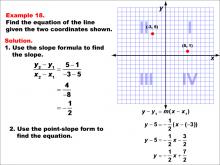
|
Math Example--Linear Function Concepts--The Equation of a Line Given Two Points: Example 18 | Math Example--Linear Function Concepts--The Equation of a Line Given Two Points: Example 18TopicLinear Functions DescriptionThis image shows a graph with two points plotted at (-3, 5) and (5, 1). The example demonstrates how to find the equation of a line using the slope formula and point-slope form. The slope is calculated as (5 - 1) / (-3 - 5) = -1 / 2. The point-slope form is used to find the equation: y - 5 = (-1 / 2)(x + 3), resulting in y = (-1 / 2)x + 7 / 2. |
Point-Slope Form and Slope-Intercept Form |
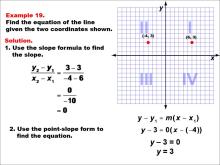
|
Math Example--Linear Function Concepts--The Equation of a Line Given Two Points: Example 19 | Math Example--Linear Function Concepts--The Equation of a Line Given Two Points: Example 19TopicLinear Functions DescriptionThis image shows a graph with two points plotted at (-4, 3) and (6, 3). The example demonstrates how to find the equation of a horizontal line using the slope formula and point-slope form. The slope is calculated as (3 - 3) / (-4 - 6) = 0. Since the slope is zero, the equation of the line is simply y = 3, indicating a horizontal line passing through y = 3. |
Point-Slope Form and Slope-Intercept Form |
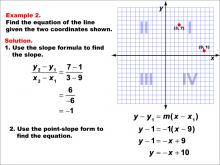
|
Math Example--Linear Function Concepts--The Equation of a Line Given Two Points: Example 2 | Math Example--Linear Function Concepts--The Equation of a Line Given Two Points: Example 2TopicLinear Functions DescriptionThis example illustrates the process of finding the equation of a line passing through the points (3, 7) and (9, 1). The slope is calculated as -1 using the formula (y2 - y1) / (x2 - x1). Employing the point-slope form, y - y1 = m(x - x1), the equation is derived as y - 1 = -(x - 9), which simplifies to y = -x + 10. |
Point-Slope Form and Slope-Intercept Form |
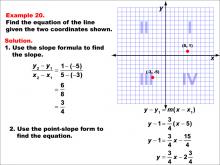
|
Math Example--Linear Function Concepts--The Equation of a Line Given Two Points: Example 20 | Math Example--Linear Function Concepts--The Equation of a Line Given Two Points: Example 20TopicLinear Functions DescriptionThis image shows a graph with two points plotted at (-3, -5) and (5, 1). The example demonstrates how to find the equation of a line using the slope formula and point-slope form. The slope is calculated as (1 - (-5)) / (5 - (-3)) = 6 / 8 = 3 / 4. The point-slope form is used to find the equation: y - 1 = (3 / 4)(x - 5), resulting in y = 3/4x - 2 3/4. |
Point-Slope Form and Slope-Intercept Form |
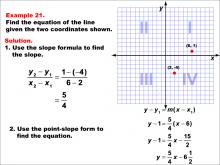
|
Math Example--Linear Function Concepts--The Equation of a Line Given Two Points: Example 21 | Math Example--Linear Function Concepts--The Equation of a Line Given Two Points: Example 21TopicLinear Functions DescriptionThe image shows a graph with two points (2, -4) and (6, 1) marked on a coordinate plane. The example demonstrates how to find the equation of a line using these two points. The slope is calculated using the slope formula, and then the point-slope form is applied to derive the equation of the line. The slope is calculated as (1 - (-4)) / (6 - 2) = 5 / 4. Using point-slope form: y - 1 = (5 / 4)(x - 6), which simplifies to y = 5/4x - 6 1/2. |
Point-Slope Form and Slope-Intercept Form |

|
Math Example--Linear Function Concepts--The Equation of a Line Given Two Points: Example 22 | Math Example--Linear Function Concepts--The Equation of a Line Given Two Points: Example 22TopicLinear Functions DescriptionThe image shows a graph with two points (5, 1) and (8, -5) marked on a coordinate plane. The example demonstrates how to find the equation of a line using these two points. The slope is calculated using the slope formula, and then the point-slope form is applied to derive the equation of the line. The slope is calculated as (1 - (-5)) / (5 - 8) = -2. Using point-slope form: y - 1 = -2(x - 5), which simplifies to y = -2x + 11. |
Point-Slope Form and Slope-Intercept Form |
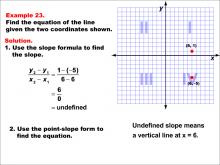
|
Math Example--Linear Function Concepts--The Equation of a Line Given Two Points: Example 23 | Math Example--Linear Function Concepts--The Equation of a Line Given Two Points: Example 23TopicLinear Functions DescriptionThe image shows a graph with two points (6, 1) and (6, -5) marked on a coordinate plane. The example demonstrates how to find the equation of a vertical line using these two points. Since both x-coordinates are equal, the slope is undefined, indicating a vertical line. The slope is undefined because x-values are equal: (1 - (-5)) / (6 - 6) = undefined. This means it's a vertical line at x = 6. |
Point-Slope Form and Slope-Intercept Form |

|
Math Example--Linear Function Concepts--The Equation of a Line Given Two Points: Example 24 | Math Example--Linear Function Concepts--The Equation of a Line Given Two Points: Example 24TopicLinear Functions DescriptionThe image shows a graph with two points (-6, -2) and (-3, 4) marked on a coordinate plane. The example demonstrates how to find the equation of a line using these two points. The slope is calculated using the slope formula, and then the point-slope form is applied to derive the equation of the line. The slope is calculated as (4 - (-2)) / (-3 - (-6)) = 2. Using point-slope form: y - 4 = 2(x + 3), which simplifies to y = 2x + 10. |
Point-Slope Form and Slope-Intercept Form |
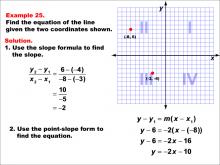
|
Math Example--Linear Function Concepts--The Equation of a Line Given Two Points: Example 25 | Math Example--Linear Function Concepts--The Equation of a Line Given Two Points: Example 25TopicLinear Functions DescriptionA graph with two points (-8, 6) and (-3, -4) marked on a coordinate plane. The slope is calculated using the formula (y2 - y1) / (x2 - x1), and the equation of the line is derived using the point-slope form. The final equation is y = -2x - 10. The slope is calculated as (-4 - 6) / (-3 - (-8)) = -2. Using the point-slope form y - y1 = m(x - x1), the equation becomes y - 6 = -2(x + 8), which simplifies to y = -2x - 10. |
Point-Slope Form and Slope-Intercept Form |
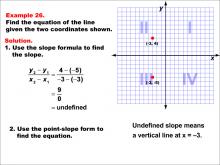
|
Math Example--Linear Function Concepts--The Equation of a Line Given Two Points: Example 26 | Math Example--Linear Function Concepts--The Equation of a Line Given Two Points: Example 26TopicLinear Functions DescriptionA graph with two points (-8, -6) and (4, 2) marked on a coordinate plane. The slope is calculated using the formula (y2 - y1) / (x2 - x1), and the equation of the line is derived using the point-slope form. The final equation is y = 1/4 x - 3. The slope is calculated as (2 + 6) / (4 + 8) = 1/4. Using the point-slope form y - y1 = m(x - x1), the equation becomes y + 2 = 1/4(x - 4), which simplifies to y = 1/4 x - 3. |
Point-Slope Form and Slope-Intercept Form |
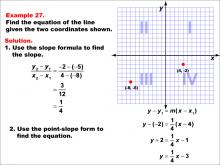
|
Math Example--Linear Function Concepts--The Equation of a Line Given Two Points: Example 27 | Math Example--Linear Function Concepts--The Equation of a Line Given Two Points: Example 27TopicLinear Functions DescriptionA graph with two points (-3, 4) and (-3, -5) marked on a coordinate plane. The slope is undefined because both x-coordinates are equal, leading to division by zero. This represents a vertical line at x = -3. The slope is undefined because (4 + 5) / (-3 + 3) results in division by zero. This indicates a vertical line at x = -3. |
Point-Slope Form and Slope-Intercept Form |
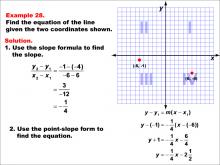
|
Math Example--Linear Function Concepts--The Equation of a Line Given Two Points: Example 28 | Math Example--Linear Function Concepts--The Equation of a Line Given Two Points: Example 28TopicLinear Functions DescriptionA graph with two points (-6, -1) and (6, 4) marked on a coordinate plane. The slope is calculated using the formula (y2 - y1) / (x2 - x1), and the equation of the line is derived using the point-slope form. The final equation is y = -(1/4)x - 2.5 or -(1/4)x - (5/2). The slope is calculated as (4 + 1) / (6 + 6) = -(1/4). Using the point-slope form y - y1 = m(x - x1), the equation becomes y + 1 = -(1/4)(x + 6), which simplifies to y = -(1/4)x - (5/2). |
Point-Slope Form and Slope-Intercept Form |
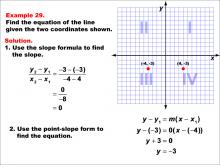
|
Math Example--Linear Function Concepts--The Equation of a Line Given Two Points: Example 29 | Math Example--Linear Function Concepts--The Equation of a Line Given Two Points: Example 29TopicLinear Functions |
Point-Slope Form and Slope-Intercept Form |
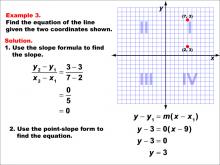
|
Math Example--Linear Function Concepts--The Equation of a Line Given Two Points: Example 3 | Math Example--Linear Function Concepts--The Equation of a Line Given Two Points: Example 3TopicLinear Functions DescriptionThis example demonstrates how to find the equation of a horizontal line passing through the points (2, 3) and (7, 3). The slope is calculated as 0 since both y-coordinates are the same. Using the point-slope form, y - y1 = m(x - x1), the equation becomes y - 3 = 0(x - any x-value), which simplifies to y = 3, representing a horizontal line. |
Point-Slope Form and Slope-Intercept Form |